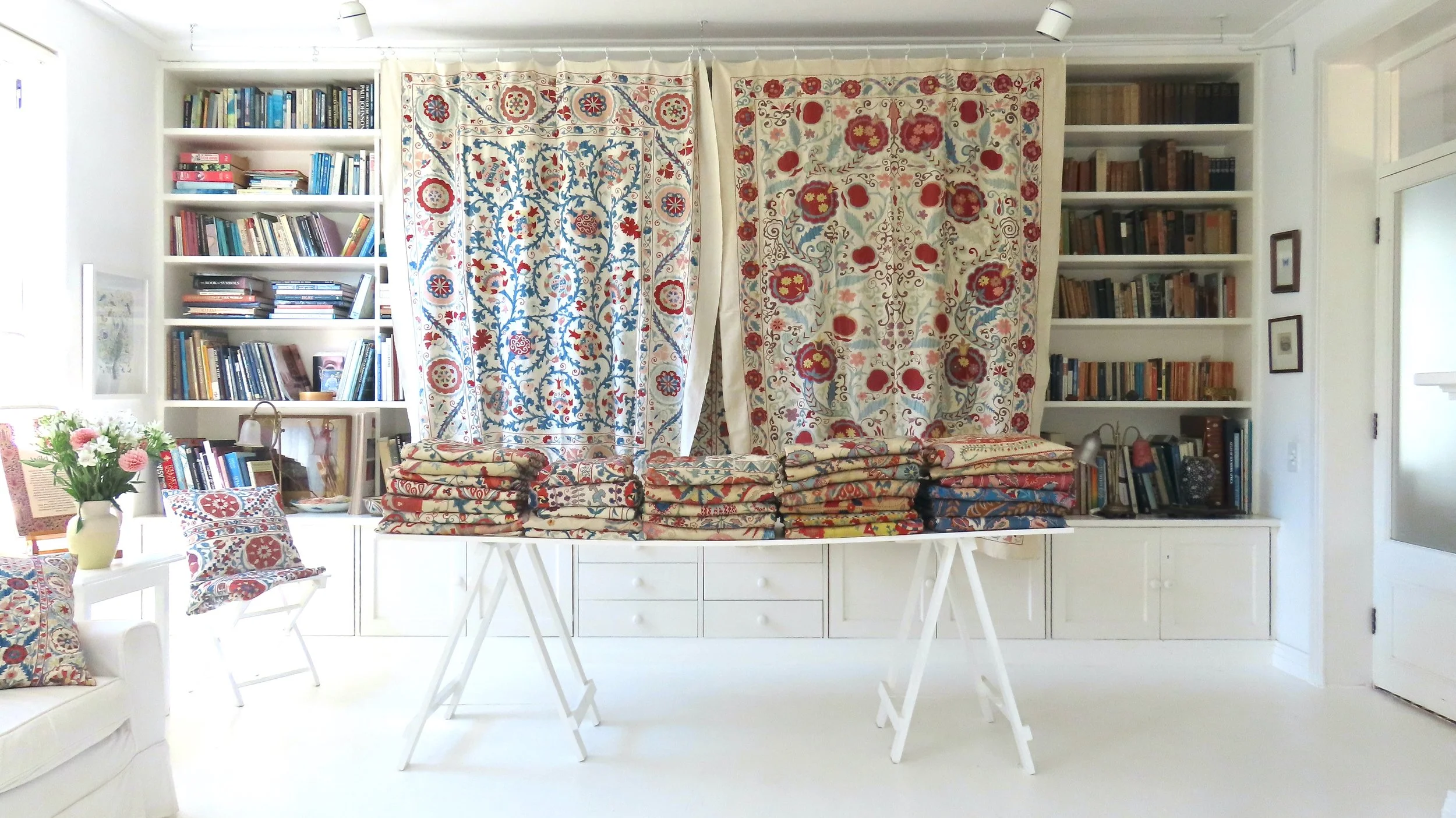Holding up an extraordinary Adras Bukhara Medallion Suzani. A “carpet” almost of heavenly embroidery in needle stitch.
His Background
Azizbek Gulyamov is the driving force and “director and producer” of the beautiful Suzanis in our Cape Town Collection, and is my Suzani soul mate and a dear friend since I saw the image of the Suzani that he posted on a Textile Blog in 2012. We have since worked and travelled a long road together to share this Beauty to the world. I have the highest regard and respect for the body of work that he has achieved with his group of artists, and feel truly privileged to be able to share these with lovers of true textile art worldwide.
Our Suzanis use only pure silk and the traditional rules of embroidery for creating Suzanis, and each one is embroidered by one woman per Suzani. Many synthetic Suzani copies have been made of our work, embroidered by groups of women working together to make Suzanis hurriedly for the online and tourist market. More and more affordable viscose copies and even printed works have sadly flooded the market. This makes it difficult to market our beautiful traditional expensive works of art.
Azizbek grew up during the Soviet time and still lives in Bukhara, and has been passionately involved in the drive to revive Suzani embroidery since Independence during the early 90’s. While he was growing up traditional Suzani embroidery was strictly discouraged, in favour of machine made export embroideries. Families treasured their inherited Suzanis and women kept embroidering armlets to wear and to practice the age-old traditional embroidery skills they had learned from their mothers.
Since the Independence of Uzbekistan from Russia it has been a celebration amongst Central Asia women to freely embroider traditional Suzanis again. To carry their embroidery heritage and the magic of Central Asian Suzani creation into the future,
In his childhood home embroidery work was highly cherished, and this memory inspired and drove him into doing the conserving work he does now to help keep this art alive.
After Independence he lived and studied in Germany for 8 years. There he researched and furthered his knowledge of antique Suzani history and design online, in museums and in private collections around the world. He returned to Bukhara to set out on his dream to contribute to the drive to create traditional Suzanis in as he called it “Noble Bukhara”.
He built his own team over time. His inspiration and designs came from his heritage and research of antique Suzanis. He stresses that he never copies, but interprets this inspiration to create new adapted beauties.
An important starting point was to find the best graphic designer to draw the designs on Adras, this takes immense skill. A Suzani can only be a success if the underlying drawing is perfect. Few artists are trained to do these very specialised Suzani design drawings. It used to be the task of an older woman, called “the kalamkash” in the family, who knew the family designs and secrets, to draw the underlying design of a Suzani for the embroiderer to follow.
Different graphic designers, mostly male artists have done this drawing work for Azizbek’s Suzanis. They prepare the drawn on cloth for the embroiderers to embroider her magic in needle and silk. It is also her art to decide the distribution and balance of the colours used.
Some Silks and Adras are still woven in bolts by families in home industries. The Silk background used for our Suzanis, was developed by Azizbek. He was the first one to commission embroideries to be done on this textile. He asked his weavers to combine silk with a cotton backing to improve its strength for the embroidery work. This “Atlas” Silk textile is now widely used for Suzani embroidery.
The silk threads are also produced by home industries. The natural dyeing and colouring of the threads is produced by yet another group. Each group keeps their family’s age old trade secrets locked away from outsiders.
He had to search for suitable team of carefully selected older women embroiderers from the villages who learned the art of Suzani embroidery in craft schools after Independence, to do the hand embroidery for his Suzani projects. He insists that each individual Suzani is embroidered by one artist only, otherwise there is not a good consistency in the stitching. When a group of women work and stitch together on a Suzani it does not have this stamp of “a work of art “ to its name. The female world of traditional embroidery artists in the hill towns and villages is very secretive and private and is strictly controlled with its very own rules.











